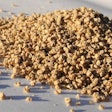
The 2012 U.S. corn crop was supposed to be one of the biggest on record with one of the largest number of acres planted since WWII, and we wouldn’t have another below trend line yield again, but it didn’t work out as planned. The drought in the Midwest drastically reduced yield, corn prices hit record highs in the summer, and the high price is rationing corn among users, foreign and domestic.
Chip Flory, editor, Pro Farmer newsletter, said that to put the drought of summer 2012 into perspective, the original corn yield estimate for the 2012-2013 U.S. corn crop was 166 bushels per acre, and the U.S. Department of Agriculture estimated in the October WASDE report that corn yield will wind up at 122 bushels per acre. This unrealized 44 bushels per acre of corn will force severe rationing of corn and keep corn prices high at least until next harvest.
High grain prices continue
During WATTAgNet’s Poultry and Grains Outlook for 2013 Webinar in October 2012, Flory projected that the average farm price per bushel of corn and soybeans would be $8 and $15.75, respectively, for the 2012-2013 crop year. He estimated that the average farm price for corn will be $6-6.50 per bushel in the 2013-2014 crop year while the average farm price for soybeans will be $12.25-13.50 per bushel. These prices assumed normal weather, and he expressed some concern regarding low soil moisture levels in October 2012.
By early December 2012, Flory had not changed his projections for corn and soybean prices because he thinks that continued dry weather in the Midwest will keep prices from falling. “We had above normal rain in October [2012], but river levels went down. We had way below normal precipitation in Iowa in November [2012],” he said. Much of Iowa only had a half an inch of rain in November 2012.
Flory said that the drought intensified just a little in the Western Corn Belt and that soil moisture levels are dryer than they were at the same time a year ago. “It is pretty frightening when you consider the condition that we could be in come spring,” Flory said.
El Niño or La Niña?
El Niño conditions are good for Midwest crops, and La Niña conditions are bad. This pattern is reversed for the Southeastern U.S. Flory said, “The official stand is that [the December 2012 weather situation] is an enso-neutral event, but if you look at the rain we have had in the Pacific Northwest and the dry conditions in the Southwest in the winter months, that is a La Niña influence.”
Flory reported that Gail Martell, Martell Crop Projections, said that because of some of the patterns we see in precipitation, we are moving back toward a La Niña episode. The areas of below normal sea surface temperatures in the Pacific in late November 2012 support this prediction that we are moving back to a La Niña, which suggests that it could be a tough growing season again in the Midwest.
Flory said that these weather developments will help to support corn and soybean prices for the remainder of the 2012-2013 crop year, so he is standing by his October 2012 estimates. Weather conditions in South America haven’t been good for grain buyers either. Wet weather in Argentina delayed corn planting, and dry weather in Brazil may restrict soybean yields.
Protein sector forecast
Dr. Paul Aho, economist, Poultry Perspective, said, “The most striking thing about poultry meat supply and demand over the last five years is the drop in U.S. per capita consumption. Consumption has dropped by 25 pounds for all meats. That kind of drop is unprecedented unless you go back to the 1930s.”
Red meat consumption has dropped from 118 pounds to 102 pounds. Even poultry has been affected, dropping from 104 pounds to 97 pounds. Aho said that one of the reasons for these declines is the recession. In most recessions, a sharp loss in jobs occurs, and then there is a sharp gain in jobs. In past recessions, after 24 months of gains in jobs, all jobs lost in the recession have been recovered. But the recession that started in 2007 is very different. The decline was sharp and deeper than past recessions, and there has been a very slow recovery from the recession. After 60 months, there is still a low rate of job recovery.
“The other reason for the drop in meat and poultry consumption is that at the same time that there has been high unemployment — a very weak job market — there has been an increase in the price of meats. The average retail price of beef has risen from $4 to $5 a pound. Pork has risen from $2.75 to $3.50, and chicken has risen from $1.60 to $2.25. The combination of the weak economy and the higher prices means that we have lost consumption,” Aho said.
U.S. chicken production has declined from 2010 to 2012 and is expected to continue to decline into 2013. “This is unusual for poultry where the norm has been increases in production and consumption,” he said. Even with the reductions in production, the U.S. broiler industry is not profitable. “The chicken industry will probably have to cut production in order to regain profitability,” Aho said.
Unfortunately, the losses are mounting in the U.S. chicken industry due to the higher grain prices and the recession. Aho projected that the fourth quarter of 2012 might be the worst period for the poultry industry, with things improving somewhat in the first half of 2013. “Production is very likely to decline over the next few months,” he said. “We may see additional consolidation in the industry, with a recovery coming sometime in 2013.”
GDP growth in 2013
As 2013 begins, the European Union is already in a slowdown or recession, according to the Paris-based Organisation for Economic Co-operation and Development. “The risk of a new major contraction cannot be ruled out. A recession is ongoing in the euro area,” said Pier Carlo Padoan, Organisation for Economic Co-operation and Development deputy secretary-general and chief economist.
The U.S. economy is harder to predict for 2013. Published reports range from the U.S. is already in another recession all the way to predictions of greater than 3 percent GDP growth for the year. At time of press, negotiations between the White House and Congress to avoid the so-called fiscal cliff were ongoing. Some analysts have suggested that an agreement, no matter what the specifics are, could provide the certainty that businesses need to invest and grow, but most are not as optimistic. It appears unlikely that the U.S. economy will grow at a fast enough pace in 2013 to spur demand for protein among consumers.
The Organisation for Economic Co-operation and Development Economic Outlook report, released at the end of November 2012, projected the world economy would grow by 2.9 percent in 2012 and by 3.4 percent in 2013, down from an initial forecast of 3.4 percent and 4.7 percent, respectively. Economies in the 17 Euro-zone countries are predicted to contract by 0.4 percent in 2013. If the U.S. avoids the fiscal cliff, the Organisation for Economic Co-operation and Development projects U.S. GDP growth of 2 percent in 2013. A Reuters poll of 70 economists came up with the same 2 percent prediction for U.S. GDP growth in 2013. These same economists said that the EU entered a recession in the third quarter of 2012, and they expect no growth in the EU in 2013.





